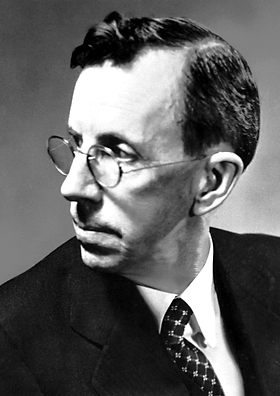Clinton Davisson facts for kids
Quick facts for kids
Clinton Joseph Davisson
|
|
|---|---|

Davisson
|
|
| Born | October 22, 1881 |
| Died | February 1, 1958 (aged 76) |
| Nationality | United States |
| Alma mater | University of Chicago (B.S., 1908) Princeton University (Ph.D, 1911) |
| Known for | Electron diffraction |
| Spouse(s) | Charlotte Davisson |
| Awards | Comstock Prize in Physics (1928) Elliott Cresson Medal (1931) Hughes Medal (1935) Nobel Prize in Physics (1937) |
| Scientific career | |
| Fields | Physics |
| Institutions | Princeton University Carnegie Institute of Technology Bell Labs |
| Doctoral advisor | Owen Richardson |
| Influenced | Joseph A. Becker Mervin Kelly William Shockley |
Clinton Joseph Davisson (born October 22, 1881, died February 1, 1958) was an American physicist. He won the Nobel Prize in Physics in 1937. He received this award for discovering something called electron diffraction. He found this during a famous test called the Davisson–Germer experiment. He shared the Nobel Prize with George Paget Thomson. Thomson also found electron diffraction around the same time.
Early Life and Education
Davisson was born in Bloomington, Illinois. He finished high school in 1902. Then, he went to the University of Chicago on a scholarship. In 1905, he started working at Princeton University as a physics instructor. This happened because Robert A. Millikan suggested him for the job.
Davisson earned his bachelor's degree from Chicago in 1908. He mostly worked on this during his summer breaks. While teaching at Princeton, he also worked on his Ph.D. research. His advisor was Owen Richardson. He received his Ph.D. in physics from Princeton in 1911. In the same year, he married Charlotte, who was Richardson's sister.
Scientific Career
After getting his Ph.D., Davisson became an assistant professor. He worked at the Carnegie Institute of Technology. In 1917, he took a break from teaching. He went to do research for the war effort. This work was with the Engineering Department of the Western Electric Company. This company later became Bell Telephone Laboratories.
After the war, Davisson decided to stay at Western Electric. He was promised that he could do basic research there. He had found that teaching at Carnegie Institute took up too much of his time. This left little time for his own research. Davisson stayed at Bell Labs until he retired in 1946. After that, he worked as a research professor at the University of Virginia. He retired for a second time in 1954.
Diffraction is what happens when a wave hits an opening or a grating. It shows how waves move. In the 1800s, scientists knew a lot about how light waves diffracted. They also understood how ripples on water diffracted. In 1927, Davisson and Lester Germer worked at Bell Labs. They did an experiment that showed electrons could also diffract. They used a crystal of nickel in their experiment.
This famous Davisson–Germer experiment proved an important idea. It confirmed the de Broglie hypothesis. This idea says that tiny particles of matter, like electrons, can also act like waves. This is a key part of quantum mechanics, which studies very small things. Their experiment was the first time anyone measured the wavelength of an electron. The wavelength they measured matched de Broglie's equation. This equation is  . Here,
. Here,  is Planck's constant and
is Planck's constant and  is the electron's momentum.
is the electron's momentum.
Personal Life
While studying at Princeton, Davisson met Charlotte Sara Richardson. She was visiting her brother, Professor Richardson. Charlotte was also the sister-in-law of Oswald Veblen, a famous mathematician. Clinton and Charlotte Davisson (who passed away in 1984) had one child. Their son, Richard Davisson, also became an American physicist.
Death and Legacy
Clinton Davisson passed away on February 1, 1958. He was 76 years old.
In 1970, a crater on the far side of the Moon was named after Davisson. The IAU gave it the name Davisson.
See also
 In Spanish: Clinton Davisson para niños
In Spanish: Clinton Davisson para niños

